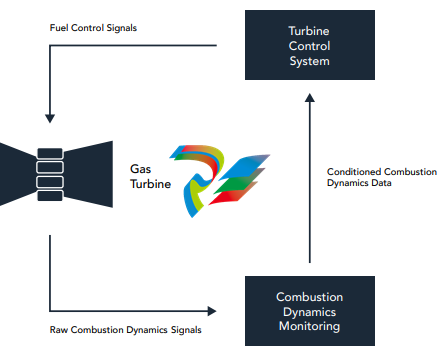
parkerVM600Mk2 A Second-Generation Architecture for a New Era
mixture is too lean. The ratio is
then adjusted (less lean) such that
the combustor is perpetually on
the verge of instability, but without
actually pulsating. In other words,
a precisely controlled balancing act
to maintain that tiny operational
zone existing between stable and
unstable combustion – a zone
where efficiency is highest and
NOx emissions lowest.
It turns out that monitoring these
pressure pulsations requires
sophisticated filtering and other
signal processing that is not unlike
the requirements of monitoring a
vibration signal – particularly those
from aeroderivative gas turbines
where accelerometers are used and
extraction of desired signal features
can be very demanding.
It was not surprising, then, that
gas turbine manufacturers turned
to vibration monitoring suppliers
to meet these needs. Vibro-meter
was among the first to rise to the
challenge and offer fully integrated
combustion dynamics monitoring
with the release of our VM600
platform and its 16-channel XMC16
module.
Indeed, the deep domain expertise
of Meggitt for supplying sensors
that can survive environmental
extremes meant that vibrometer could supply not only the
necessary monitoring system, but
the associated high-temperature
dynamic pressure sensors, able to
survive in one of the most extreme
of all machinery environments:
gas turbine combustors where
conditions at the measurement
locations can approach 700°C and
250 bar.
1. Zink, John C., “Progress
continues in gas turbine NOx
control” Power Engineering. May
1, 1996. Retrieved September 19,
2021.
2. Richards, G A, and Lee, G T. “Gas
turbine combustion instability”.
US Dept of Energy. September 1,
1996. Retrieved September 19,
2021.
Combustion dynamics monitoring
is part of closed-loop control to
ensure that damaging pulsations
in low-NOx gas turbines do not
prematurely age or destroy the
combustor cans. The pulsations
occur because today’s lowNOx technologies rely on
inherently metastable combustion
conditions that burn fuel in the
leanest possible manner but can
produce an unstable flame if not
meticulously controlled

Full API 670 compliance
Within the petrochemical sector, the importance of American Petroleum
Institute standards for machinery and its associated instrumentation
cannot be overstated.
These standards are no longer considered best practice employed by the
cutting-edge few – they are so universally accepted that they are today
considered standard practice and thus widely embraced by the many.
Nowhere is this more true than with API Standard 67023 which defines the
necessary attributes of machinery protection systems.
The first edition of this standard was released in 1976 and has been so
successfully embraced that it has resulted in five successive revisions to
keep pace with industry’s changing needs: the 6th edition of the standard
is currently in preparation and is expected to be released by 2023.
Indeed, it provides such value that it has remained among the API’s bestselling standards in the more than 45 years since its introduction. Not
surprisingly, the VM600 was designed with full API 670 compliance in
mind, allowing customers in the oil & gas industries to employ the system
with the confidence that it rigorously adheres to the robust feature set
and functionality that multiple generations of users and manufacturers
have found important.
Indeed, the requirements of 670 are so well-recognized by practitioners
in all industries that it is not uncommon to find power generation
and other customers using it as the basis of their own purchasing
specifications – not just those in the petroleum industries.
3. API Standard 670 “Machinery Protection Systems”. American Petroleum
Institute. Washington, DC. November 2014.
Full API 670 compliance
Both first- and second-generation
VM600 platforms are fully
compliant with the 5th edition
of API 670. Additionally, we
participate on the API Task Force
that is currently preparing the 6th
edition to ensure we remain fully
compliant with and abreast of
industry changes as the standard
evolves.

Why a Second-Generation product?
With such a rich feature set and pedigree of innovation, it is natural to ask
why a second-generation platform was even necessary.
There are multiple reasons:
Cybersecurity
When the VM600 was originally
designed, the internet itself
was not even a decade old. The
idea that this global network
infrastructure would someday
become a remotely accessible
means to sabotage industrial
instruments and automation
systems wasn’t even part of
anyone’s thought process at the
time. But the intervening 22 years
have changed everything.
Today, cybersecurity is at the very
top of customer concerns. What
has also changed are the types
of customers concerned about
cybersecurity. For decades, the
most innovative and demanding
customers were largely in the
petroleum and oil & gas sectors.
They were often the ones with




























































































































